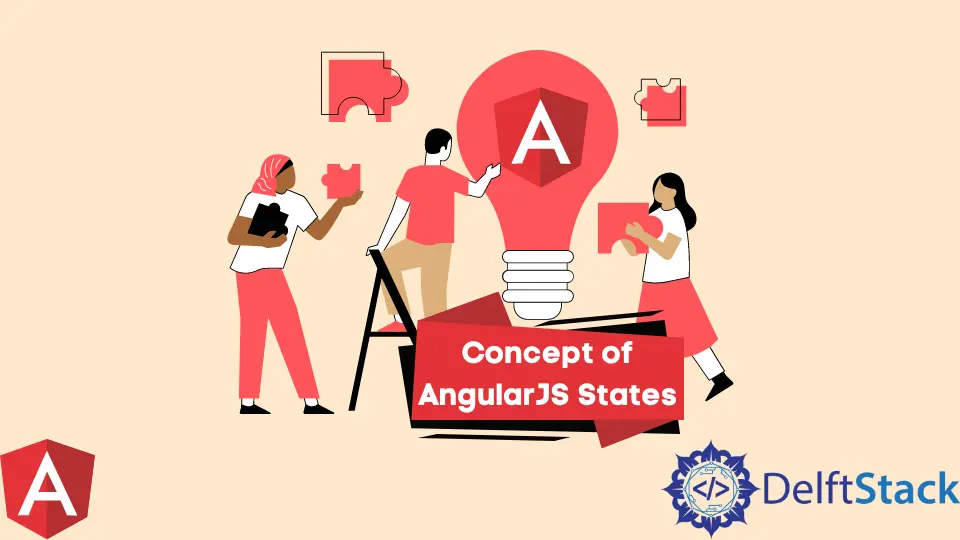Concept of AngularJS States
-
the Concept of
Statesin AngularJS -
Initialize a
Statein AngularJS -
Use the
Stateproviderto Provide the State for Any Given Application in AngularJS -
Difference Between
$stateProviderand$routeProviderin AngularJS -
Example of AngularJS
States

This article will explore the concept of State in AngularJS and how to use it to build a simple application.
the Concept of States in AngularJS
The STATE in AngularJS is a mechanism that allows us to update the view based on changes to the model. It is a two-way binding between data and DOM elements.
Moreover, the State helps us keep track of data that changes over time, such as whether a particular button has been pressed or not.
Initialize a State in AngularJS
Configuring a STATE in AngularJS is relatively easy. Use the State() method of the $stateProvider service to configure a state.
The arguments stateName and stateConfig are used in this procedure. stateName is a one-of-a-kind name for a state, and it may be something like /home, /aboutus, /Contactus, and so on.
The stateConfig is a state setup object having properties like templates, templateURL, and ResolveURL.
Use the Stateprovider to Provide the State for Any Given Application in AngularJS
The $stateProvider is a module used in AngularJS to provide the State for any given application.
You don’t have to use a direct link to a route to provide the State with a name, a different controller, or a different perspective.
More or less, it behaves the same as the $routeProvider, but instead of URLs, it focuses solely on State. We can take advantage of various features provided by UI-Route.
Moreover, you can have numerous ui-views on a single page. Various views can be nested and maintained by establishing State in the routing step.
Click here to learn more about Angular State provider.
Difference Between $stateProvider and $routeProvider in AngularJS
$stateProvider |
$routeProvider |
|---|---|
It makes use of the ui-router third-party module to augment and expand routing features. |
It makes use of the ngRoute AngularJS module. |
It renders the $stateProvider.state() |
It renders the $routeProvider.when() |
ui-router creates routing depending on the application’s current state. |
ngRoute uses the route URL to perform routing. |
ui-router makes use of $state.go() |
ng-router makes use of $location.path() |
To move from one page or section to another: $state.go('Services'); |
To move from one page or section to another: $location.path('Services'); |
Example of AngularJS States
To clearly understand the concept of states, let’s discuss an example.
Our first step is to define the $stateProvider.
var app = angular.module('app', ['ui.router']);
app.config(function ($stateProvider, $urlRouterProvider) {
$urlRouterProvider.otherwise("/index");
$stateProvider
After that, let’s write the complete JavaScript and HTML code.
var app = angular.module('app', ['ui.router']);
app.config(function ($stateProvider, $urlRouterProvider){
$urlRouterProvider.otherwise("/index");
$stateProvider
// index
.state('index', {
url: "/index",
views: {
'menu-view': {
templateUrl:"menu.html"
},
'container-view': {
templateUrl:"home.html"
},
'left-view@index' :{
templateUrl:"entries.html"
},
'status-view': {
template:"<p>index<p>"
},
},
})
.state('entries', {
url: "/entries",
views: {
'menu-view': {
templateUrl:"menu.html"
},
'container-view': {
templateUrl:"entries.html"
},
'status-view': {
template:"<p>entries<p>"
},
},
})
.state('entries.add', {
url: "/add",
views: {
'bottom-view@entries': {
templateUrl:"entries.add.html"
},
'status-view@': {
template:"<p>entries.add<p>"
},
},
})
.state('entries.list', {
url: "/list",
views: {
'bottom-view@entries': {
templateUrl:"entries.list.html"
},
'status-view@': {
template:"<p>entries.list<p>"
},
},
})
});
<html>
<head>
<meta charset="utf-8">
<link rel="stylesheet" href="https://stackpath.bootstrapcdn.com/bootstrap/4.4.1/css/bootstrap.min.css" integrity="sha384-Vkoo8x4CGsO3+Hhxv8T/Q5PaXtkKtu6ug5TOeNV6gBiFeWPGFN9MuhOf23Q9Ifjh" crossorigin="anonymous">
<script src="//cdnjs.cloudflare.com/ajax/libs/jquery/2.1.1/jquery.js"></script>
<script src="//cdnjs.cloudflare.com/ajax/libs/angular.js/1.3.3/angular.min.js"></script>
<script src="//cdnjs.cloudflare.com/ajax/libs/angular-ui-router/0.2.11/angular-ui-router.min.js"></script>
<script src="//cdnjs.cloudflare.com/ajax/libs/angular-ui-bootstrap/0.12.0/ui-bootstrap-tpls.min.js"></script>
<script src="https://maxcdn.bootstrapcdn.com/bootstrap/3.3.1/js/bootstrap.min.js"></script>
</head>
<body ng-app="app">
<div class="container">
<div class="row">
<div ui-view="menu-view" class="col-md-2"></div>
<div ui-view="container-view" class="col-md-10"></div>
</div>
<div class="pull-right">
<div style="width: auto; float:left; margin-right:10px">status:</div>
<strong style="width: auto; float:left;" ui-view="status-view"> </strong>
</div>
</div>
<script id="menu.html" type="text/ng-template">
<div class="alert alert-info">
<h3><a ui-sref="index">Home</a></h3>
<h3><a ui-sref="entries">Entries</a></h3>
</div>
</script>
<!-- home -->
<script id="home.html" type="text/ng-template">
<h4>Home</h4>
<div ui-view="left-view" class="col-md-7">
</script>
<script id="entries.html" type="text/ng-template">
<div class="alert alert-warning">
<strong>Entries</strong>
<h5><a ui-sref="entries.add">add new</a></h5>
<h5><a ui-sref="entries.list">view list</a></h5>
<div style="background:white">
<div ui-view="bottom-view"></div>
</div>
</div>
</script>
<script id="entries.add.html" type="text/ng-template">
Create new Entry <input type=text/>
</script>
<script id="entries.list.html" type="text/ng-template">
<ol>
<li>First Entry</li>
<li>Second Entry</li>
<li>Third Entry</li>
</ol>
</script>
<script id="arrivals.html" type="text/ng-template">
<div class="alert alert-success">
<div style="background:white">
<div ui-view="bottom-view"></div>
</div>
</div>
</body>
</html>
To check the complete working code mentioned above, click here.
Muhammad Adil is a seasoned programmer and writer who has experience in various fields. He has been programming for over 5 years and have always loved the thrill of solving complex problems. He has skilled in PHP, Python, C++, Java, JavaScript, Ruby on Rails, AngularJS, ReactJS, HTML5 and CSS3. He enjoys putting his experience and knowledge into words.
Facebook